Help my Fiddle Leaf Fig
Can anyone help diagnosis what's wrong with my FLF?
It's been thriving for over a year and out of blue this happens. I use a moisture meter so I know I'm not overwatering. I also checked for pests and didn't see anything.. Could it be out growing it's pot? Or a possible fungus disease? Let me know what you think!
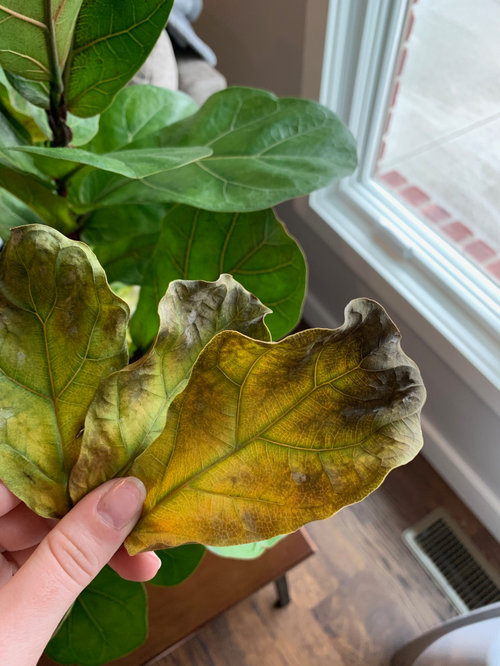
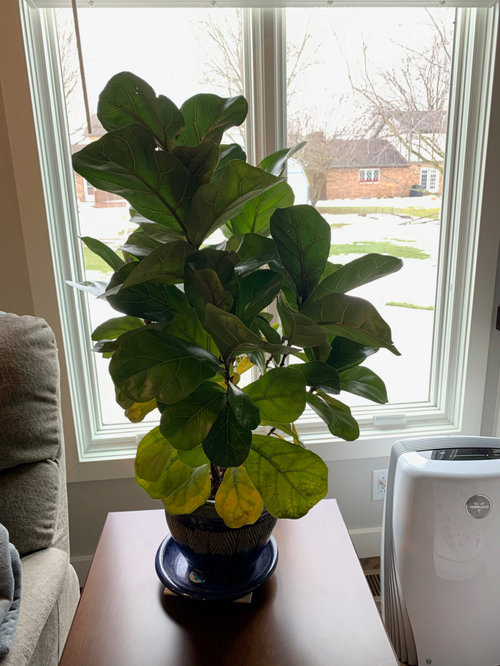
Comments (29)
SoCal Stewart (San Diego, Ca Zone 10A/10B)
3 years agoWhere on the plant were those leaves growing? If low down on the stem/trunk, could they be older leaves that have lived their life & simply shedding?
I have the ‘Bambino’ variety for about a year now so also new to FLF.
Kelly
Original Author3 years agoYes, they started at the very bottom. I thought that too! But now it's continuing up the plant and has reached the middle of it so I'm not so sure.
Related Discussions
Help my fiddle leaf fig
Q
Comments (51)Yes - that's what I would do. I didn't mention it because I didn't want to give you the impression you did something 'wrong'. I'm glad you figured it out on your own. Being root bound is limiting, but it's not something you'd consider immediately life threatening. A rootbound ficus doesn't crash like some plants, it just slowly declines with a little pick-me-up each time it's potted up. I think it's better to be patient & suffer some limitation associated with root congestion than pot up just before winter and maybe risk some root issues if you're not really careful. Al...See MoreHelp my fiddle leaf fig!!!
Q
Comments (1)Hi mnromero! I found this pretty detailed forum that answers questions about pruning FLF and some problems they face: Pruning Ficus Lyrata. When my FLF gets big enough to prune I plan on revisiting this site for suggestions. Hope this helps out....See MorePlease help my fiddle leaf fig!
Q
Comments (1)I think it looks fine. I would leave it alone and let it grow. The two branches with the stick for support will not fuse together without a whole lot of training. My recommendation would be leave it alone so it makes a nice thick and healthy plant. In the future if you are adamant that you want a single branch tree...try to buy one like that. These are slow growing if you keep them indoors and sometimes drop a few leaves when they adjust to being moved. Yours looks fine and is a nice specimen. Enjoy it!...See MoreRoot Rot?! Please help my Fiddle Leaf Fig!
Q
Comments (10)Hello! So it seems that You do have root rot. Root rot in fiddle leaf figs is vary common, Yet vary deadly if you don't act fast, You did the right thing by drying out the rootball. The next step is to Inspect the roots and remove any wet, soggy, Or browning roots. After that there is not much more you can do but put it in Fast draining soil and not water it for a while in a well draining pot. I believe that at this stage, It will recover. Just a future tip, When potting a FLF, don't use a pot that is to much bigger than the rootball, A pot that is too big will retain water, And cause root rot. I hope this helped, Good luck on saving you fig. Best Regards, Aidan....See Moretapla (mid-Michigan, USDA z5b-6a)
3 years agoAm I seeing a heat vent on the floor next to the plant, or, is it a cold air return?
Does the pot have a drain hole?
Have you been fertilizing? with what? If the plant is suffering nutritional deficiencies, especially deficiencies of the mobile nutrients N, P, K, MG, it will actually "sacrifice" older foliage in order to reclaim mobile nutrients therein contained. Once usable nutrients and other bio-compounds are reclaimed from affected leaves, the leaves are shed and their newly made available benefits are used to fuel new growth.
That you use a moisture meter that indicates you are not over-watering isn't reliable enough that you can be sure. MMs measure the electrical conductivity of the soil/soil solution. Clean the tip and insert the probe in a clean cup of distilled water and the probe will tell you the water is dry. Add a pinch of salt and it will read on the wet side. Using a wooden "tell" as a way to "tell" you when it's time to water is a much more reliable method. See the short piece I wrote about using a "tell" below.
It's not unusual for lower leaves to be shed A) in response to a reduction in photo load caused by a lower light setting, or B) new growth shading out the lower leaves.
Using a 'tell'
Over-watering saps vitality and is one of the most common plant assassins, so learning to avoid it is worth the small effort. Plants make and store their own energy source – photosynthate - (sugar/glucose). Functioning roots need energy to drive their metabolic processes, and in order to get it, they use oxygen to burn (oxidize) their food. From this, we can see that terrestrial plants need plenty of air (oxygen) in the soil to drive root function. Many off-the-shelf soils hold too much water and not enough air to support the kind of root health most growers would like to see; and, a healthy root system is a prerequisite to a healthy plant.
Watering in small sips leads to avoid over-watering leads to a residual build-up of dissolved solids (salts) in the soil from tapwater and fertilizer solutions, which limits a plant's ability to absorb water – so watering in sips simply moves us to the other horn of a dilemma. It creates another problem that requires resolution. Better, would be to simply adopt a soil that drains well enough to allow watering to beyond the saturation point, so we're flushing the soil of accumulating dissolved solids whenever we water; this, w/o the plant being forced to pay a tax in the form of reduced vitality, due to prolong periods of soil saturation. Sometimes, though, that's not a course we can immediately steer, which makes controlling how often we water a very important factor.
In many cases, we can judge whether or not a planting needs watering by hefting the pot. This is especially true if the pot is made from light material, like plastic, but doesn't work (as) well when the pot is made from heavier material, like clay, or when the size/weight of the pot precludes grabbing it with one hand to judge its weight and gauge the need for water.
Fingers stuck an inch or two into the soil work ok for shallow pots, but not for deep pots. Deep pots might have 3 or more inches of soil that feels totally dry, while the lower several inches of the soil is 100% saturated. Obviously, the lack of oxygen in the root zone situation can wreak havoc with root health and cause the loss of a very notable measure of your plant's potential. Inexpensive watering meters don't even measure moisture levels, they measure electrical conductivity. Clean the tip and insert it into a cup of distilled water and witness the fact it reads 'DRY'.
One of the most reliable methods of checking a planting's need for water is using a 'tell'. You can use a bamboo skewer in a pinch, but a wooden dowel rod of about 5/16” (75-85mm) would work better. They usually come 48” (120cm) long and can usually be cut in half and serve as a pair. Sharpen all 4 ends in a pencil sharpener and slightly blunt the tip so it's about the diameter of the head on a straight pin. Push the wooden tell deep into the soil. Don't worry, it won't harm the root system. If the plant is quite root-bound, you might need to try several places until you find one where you can push it all the way to the pot's bottom. Leave it a few seconds, then withdraw it and inspect the tip for moisture. For most plantings, withhold water until the tell comes out dry or nearly so. If you see signs of wilting, adjust the interval between waterings so drought stress isn't a recurring issue.
Al
Kelly thanked tapla (mid-Michigan, USDA z5b-6a)Kelly
Original Author3 years agoThanks for the thorough response! ( read last paragraph for plant update )
To answer your questions: Yes, that is a heating vent, but the plant does not get direct air from it. No I was not fertilizing recently, or really at all, but a few months back I did experiment with adding some coffee grounds to the top of the soil to see how it would react, not sure if that was a good idea or not :/. I have not used any kind of chemical or even other natural fertilizer. So it definitely could've been caused by some nutrient deficiency like you mentioned.
Despite your concern with the moisture meter, I still don't think the problem stemmed from water habits. But thanks for the tip on the wooden dowel. I also wasn't convinced it was simply shedding older leaves - I assumed that early on and let it continue and noticed the sick looking leaves started to continue much further up on the plant even on to some of the newer leaves..
I do have an update though. I decided to repot it and it was indeed pretty root bound (though, still not sure if that was reason for the sick looking leaves). In the process of repotting and removing old soil, I noticed a very odd substance (forgot to take a picture). It had the consistency of soil but was a very bright tan/orange color and it was throughout the pot in clumps. I've never seen anything like it and still cannot figure out what it is despite all the googling I've done. I'm assuming some kind of fungus? Whatever it was it made me nervous so way I spent hours removing all the old soil (soaking the plant in water overnight, using a spray hose, etc). I should mention this plant was notorious for getting white fungus on the top of it's soil before, and from doing some research supposedly that stuff is harmless so I never thought anything of it after that.tapla (mid-Michigan, USDA z5b-6a)
3 years agoI'll make some broad observations that come to me as I read your most recent.
You cannot depend on nutrients locked tight in the hydrocarbon chains that make up soil particles to feed the plant. If the plant suffers deficiencies, it will steal nutrients from old leaves to provide the building blocks for new growth, then shed the old leaves.
Forum discussions frequently center on the question of adding dilute coffee/tea or grounds to plants as a 'tonic', but Arabica (coffee) and Camellia (tea) are known for their toxic alkaloid (caffeine) content and their allelopathic affect on plants as well as autotoxic (poison to their own seedlings) effects on future generations. Caffeine interferes with root development by impairing protein metabolism. This affects activity of an important bio-compound (PPO) and lignification (the process of becoming woody), crucial steps for root formation.
We also know that the tannins in both coffee and tea are known allelopaths (growth inhibitors). There are ongoing experiments to develop herbicides using extracts from both coffee and tea that cause me to want to say they might serve better as a nonselective herbicide than as a tonic. I would not use either (stale coffee or tea) by applying directly to my plants - especially containerized plants; nor would I add tea bags/coffee grounds to my container soils.
"I also wasn't convinced it was simply shedding older leaves - I assumed that early on and let it continue and noticed the sick looking leaves started to continue much further up on the plant even on to some of the newer leaves." Over/under-watering, nutritional deficiencies, tight roots/rootbound, a decrease in light levels, sudden chill or temps too cool (below 60*), insects, root infections/rot, are all things that could cause loss of foliage.
..... can't say what the masses were you found in the roots, but it sounds fungal. Perhaps do a quick search to see what root mealybug looks like to see if you can eliminate that potentiality? Probably wouldn't hurt at this point to include an antifungal suitable for use as a soil drench the next time the plant needs water.
Al
Kelly thanked tapla (mid-Michigan, USDA z5b-6a)tropicofcancer (6b SW-PA)
3 years agoCould those tan/orange thingies be controlled release fertilizer prills like Osmocote? They come various sizes and colors depending on the manufacturer. Also often many gardeners get freaked out when they see those. But they are sort dull especially when they are spent.
Kelly thanked tropicofcancer (6b SW-PA)Kelly
Original Author3 years agoI guess it could be! But the substance was in two different masses and not dispersed throughout the soil.
morpheuspa (6B/7A, E. PA)
3 years agoGiven what you've already said (you're not feeding) and the fact that Osmocote just doesn't last for years, I think my own first couple of thoughts are that the soil is expended of resources and nothing's coming in.
Figs aren't big feeders, fortunately.
(I'm not a fan of Osmocote; it's a polymer-coated fertilizer, or a plastic. That's not a problem for the plant or soil, but the polymer hangs around, eventually, as all things do, ending up in the soil, water courses, and ocean. There are better options that don't involve plastics, even if they're less convenient. The polymer breaks down in light only into smaller pieces, it is not fully biodegradable. But to each his or her own; if you choose to use it, I won't say anything other than this).I've always felt it's not a perfect choice for plants in light mix, but that's just me. Other opinions vary and that's fine. Make sure to choose a version with an NPK ration of about 4 - 1 - 2 and that includes micro-elements like iron, calcium, magnesium, manganese, and sulfur.
Miracle Gro or DynaGro will both work very well, are water-soluble and mixed with your watering, and are very easy to apply. MG is cheaper per unit price. Personally, I find DG overpriced for what's in it. Both contain micro-elements, which you do want.For a fig, follow any good online feeding guide.
The other thing I'd suspect first here? It could use a repot like that Monstera. :-) If it's been some time, the soil may be tapped. Figs aren't particularly touchy about this, but the dying base leaves are a bit of a giveaway. Unseat it, see if the roots are girdling.
A cold shot would be #3, but all the other leaves seem really, really happy so...probably a distant third. Usually house air just doesn't layer like that.tapla (mid-Michigan, USDA z5b-6a)
3 years agolast modified: 3 years agoAll plants in the mullberry family, Moraceae, which includes figs, are genetically vigorous fast growers and heavy feeders. Production facilities almost exclusively use either 2:1:2 or 3:1:2 ratio fertilizers, even under shade cloth, for all species of figs, even the hardy fig F carica. Miracle-Gro's most popular soluble fertilizers, 24-8-16 and 12-4-8, are both 3:1:2 ratios, just like Foliage-Pro 9-3-6 is a 3:1:2 ratio. There is a reason for their popularity. The average plant uses about 10x as much N as P, about 3/5 as much K as N, and 3:1:2 ratios are an extremely close match to that proportion ...... purposely.
There is an optimum proportion of nutrients in the soil solution that mimics as close as possible the ratio at which nutrients are actually absorbed. Whenever the nutrient ratio in the soil solution varies significantly from the ratio at which the plant uses nutrients, it becomes more difficult for plants to absorb nutrients in the appropriate proportion. E.g., too much N (as would be supplied with a 4:1:2 ratio for houseplants) affects uptake of K, Cu, and B (see a Mulders chart); AND, it unnecessarily raises the TDS/EC levels of the soil solution, making it more difficult for plants to take up water and the nutrients therein dissolved. Not to mention the fact that I doubt MG even MAKES a fertilizer with a 4:1:2 ratio. It's bread and butter come from 3:1:2, 1:1:1, and 3:1:1 ratios with a lesser market for 5:26:5 and 3:6:3 ratios.
So others can be clear, calcium, magnesium, and sulfur are macronutrients along with nitrogen, phosphorous, and potassium, though they are occasionally referred to as secondary macronutrients. In either case, they are not micronutrients, though the iron and manganese you listed are.
Finally, a quart of FP 9-3-6 runs about $18/quart, which makes 1,064 gallons of maintenance strength fertilizer solution ...... so less than 2 cents per gallon. When you deduct the cost of an alternate brand of fertilizer from the cost of the FP, how much can you possibly save? I don't fertilize with Miracle-Gro for the same reason I don't feed my dogs table scraps. I care about their well-being.
morpheuspa (6B/7A, E. PA)
3 years agolast modified: 3 years agoWe should note here I don't have a dog in this fight. I actually make my own fertilizer at home because I'm more than enough of a home chemist to do so with complete competency, beating the price on MG by about 85% and Dynagro by...far more than that.
Thank you for catching my mistype, that actually was a mistake. Because of course, Miracle Gro is a 3-1-2.
"So others can be clear, calcium, magnesium, and sulfur are macronutrients along with nitrogen, phosphorous, and potassium, though they are occasionally referred to as secondary macronutrients."
You will find them referred to as secondary nutrients. Neither micro- nor macro- is necessarily correct. But if you wish to quibble over a word, I'll give this one to you if you feel you must have it. Personally, I'd really call the second-tier, neither micro nor macro, but it rather clouds the issue and isn't important.
What you have not addressed is any of the points I brought up while quibbling over this. Nor the fact that most of those secondary nutrients have other issues in said mix. If you'd rather not discuss this, you have only to say so.
Prices as argued are...interesting, but again, not really applicable. Most people seem to use it at higher rates. It's interesting to note that MG is three times the concentration of NPK, so would have to be three times the price to equal the price/gallon equivalency. Looking online, it is not. So per-app, I can actually beat that...including the extras, which find use in my gardens as well. As to whether said extras are even necessary or desirable is quite another story. Personally, without good soil testing, I would argue not.
"I don't fertilize with Miracle-Gro for the same reason I don't feed my dogs table scraps. I care about their well-being."
https://kreativcopywriting.com/10-logical-fallacies-know-spot/
#3 with a note of #10. It means nothing. Incidentally, popularity wouldn't be a valid reason to use anything either. Popularity would be a violation of #9. The crowd doesn't necessarily have an education in nutrients, reading a simple scientific paper, CEC of pine bark, and can often be swayed by a pretty speech at any time.
ETA: In any good debate, this would be grounds for an automatic fault. It's an attempt to shut down conversation by insult and not much else. I've re-edited this for now and I'm simply going to assume you simply didn't realize. We'll see where it goes from here, if anywhere.
Kelly
Original Author3 years agoThanks for all the discussion! I'm still not sure what's wrong with this guy but I did end up repotting.
What's your guys' opinions on worm castings? That's what I ended up mixing into the soil when I repotted, I also might try liqui-dirt sometime. I like the idea of a more natural fertilizer that way I can't overdo it, or if I do, it won't affect the plant too much. But yeah I'm still pretty clueless when it comes to fertilizer. I also just used plain old miracle grow potting soil and extra perlite if you're curious .
Update:Yeah, its still pretty sad. It's been in it's new pot and soil for a few days now and I'm still seeing new sick leaves (but they could've already been in the process of dying from before). Does anyone know if they'll grow back on the bottom? Since it typically grows new leaves from the top I'm just assuming it will never have the full shape with the bottom leaves again (if it ever gets healthy) But I don't know that for sure. Just curious if anything will come off of these nodes where the leaves previously were.
Thanks again for all the info!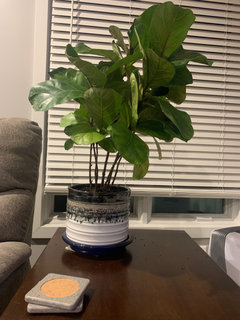
tapla (mid-Michigan, USDA z5b-6a)
3 years agoIf you're using an appropriate fertilizer, like FP 9-3-6, there is nothing essential in worm castings that isn't in the fertilizer. Container gardening is much closer to hydroponics that it is to growing in the ground. If you compare how we water our containers, you'll see how close container culture is to ebb and flow hydroponics. When the container grow medium is structured such that it allows you to water correctly w/o the plant having to pay an 'over-watering tax' - so you're flushing the soil when you water, fertilizing and precise control over your fertilizing regimen is very easy. That is why it's far better to keep center focus on the structure of container media and it's ability to maintain its structure than on media components ability to feed the plant.
Improving cultural conditions, particularly additional light and air movement CAN stimulate back-budding from latent buds in leaf axils or above leaf (bundle) scars that remain after a leaf is shed; and, you can force back-budding under the right conditions if you prune hard or the plants state of vitality allows hard pruning and/or partial defoliation, but you would do much better to focus on improving currently stressful cultural conditions.
There is something called Liebig's Law of the Minimum (or of Limiting Factors), which states there are 6 broad factors that affect plant vitality/growth/yield; they are: air, water, light, temperature, soil/media, nutrients. Within the nutrient category there are a number of nutrients governed by Liebig's Law as well. Liebig's Law states the most deficient factor limits plant growth, and increasing the supply of non-limiting factors will not increase plant growth. Only by increasing most deficient factor will the plant growth increase. There is also an optimum combination of the factors and increasing them, individually or in various combinations, can lead to toxicity for the plant.
It's highly unlikely you'll find success trying magic elixirs and tonics, or adding a little extra this or that because you heard plants might like it, before you bring basic factors up to levels you can see the plant approves of. In the same sense that "too many cooks spoil the broth", it's equally true that trying to incorporate every suggestion that catches your attention, sounds good, or reasonable, is far more likely to hinder you than help you.
Take care. ~ AlKelly
Original Author3 years agoDave, I'm not sure which Clare person you're referring to or which link, regardless thanks for weighing in.
I'm honesty a bit overwhelmed with this discussion haha. I started growing my plant collection just a year ago, going from 1 to over 30 plants and up until now, I have never dealt with any kind of pests, fungus or other diseases so it was only a matter of time. It's clear I still have a lot of learning to do. Though overwhelming, it was informative and there are certainly things I now know I could be doing better when it comes to plant care. I ended up ordering some dynogrow and promise to be a better feeder from now on :D
Tapla, regarding your comment about ruling out root mealy bugs, that's a good point. I looked into it, and I can't rule it out for sure. Like I mentioned, this plant did have quite a bit of white looking fungus as well, something that I thought was fine considering it wasn't moving and from other resources I read said it could be harmless. But also like a mentioned, I've never dealt with pests before, so I very well could just be ignorant to what I'm looking for. (Mealy bugs wouldn't explain the mysterious orange mass though). I think I will give this an anti-fungus solution just in case, any recommendations welcome.tropicofcancer (6b SW-PA)
3 years agoKelly, soil fungus are quite common and generally harmless. Most of the time they are not visible but are there. Sometimes you will see white fuzzy stuff - called mycellium. Depending on the type of fungus you may also see a mushroom or two. Often organic matter added bagged soil are the primary source.
On the other hand, if they look like small grains of rice then it could be mealy bugs. Hard to get rid off without systemic insecticides. Much easier if they are on leaves and stems. Easiest is to repot completely, washing the roots and use fresh soil. But you have done that already. Insecticides containing pyrethrins are supposed to help but I have no experience with its real effectiveness.
Clare is the person who started the FLF site: https://fiddleleaffigplant.com/. She was a member here pushing her site here. But like most sites the content and products both are very poor, inaccurate and misleading. She jumped on the FLF craze and probably is making good bit out of it.
Kelly thanked tropicofcancer (6b SW-PA)tapla (mid-Michigan, USDA z5b-6a)
3 years agolast modified: 3 years agoKelly, she's another of those who make up science they think sounds good, because she's not knowledgeable enough to know what she is seeing. As it turns out, the "3:1:2 RATIO fertilizer" she hawks as the end-all for Ficus lyrata ends up costing the grower 192x as much as FP 9-3-6 because it so diluted. I calculated the fertilizer to have the shamefully low %s of approximately 0.28 : 0.09 : 0.06
If someone guarantees you can use a fertilizer product per instructions every time you water, as she suggests, w/o taking into account someone's watering habits and soil choice, the actual amount of fertilizer in the solution would have to be nearly nil. There was another product that many at GardenWeb/Houzz swore was the best thing they ever used and was capable of miraculous things. It was called Eleanor's VF11. As it turned out, the actual % of NPK in VF-11 was 0.15 - 0.85 - 0.55 This is less than 1% of ANY of the macro nutrients - roughly 1/8 of 1% N, 7/8 of 1% P, 1/2 of 1% K.
Caveat Emptor!
I wrote a short Overview of Good Growing Practices a few years ago. It can help you focus on the basics, and if used as a guide to practical applications, will help you avoid all the most common pitfalls almost every hobby grower runs up against. See what you think. I'm sensing you're overwhelmed by both the amount of information and the conflicting information you're getting. Just know that growing well is very easy. The reason for an extremely high % of the issues growers come here seeking help for are related to use of poor media, more specifically, media which hold too much water and too little air for too long. When you get to a place where you can water to beyond soil saturation without the medium remaining wet for such an extended period neither root function or root health are significantly affected after a thorough watering, you're over the hump. At that point, fertilizing will have become nothing more than following the simplest of routines, leaving light levels and temperatures as your main focus, both of which are quite straight forward. Your plants' natural defenses against insects and diseases are a byproduct of your plants' metabolic rates, so learning to keep them healthy goes a long way toward avoiding pathogens and insect herbivory.
*********************************************************************************
The most common causes of necrotic leaf tips and margins are over-watering and a level of TDS/EC that's too high (too high a salt level in the soil solution). Anything affecting root health or function can cause necrotic tips and margins, and is responsible for a very high % of problems brought to fora for resolution.
Knowledgeable chemists and plantsmen should know Dyna-Gro doesn't tout the fact that it contains chlorine, a volatile gas. Cl- is present in fertilizers as the chloride anion. Several nutrients which are very valuable to plants and essential to maximizing vitality, mass, and yields, are not technically ESSENTIAL only because they are not necessary for the plant to complete its life cycle. Sodium, silicon, and selenium are prime examples of nutrients essential to a plant's well-being, even though they are not necessarily essential to ensuring viability. As is true for all chemicals that make their way into the soil solution, the poison/toxicity is in the dose, or in some cases active synergists. Representing there is anything more than a remote chance that the Na in Foliage-Pro is anything more than a infinitesimally tiny risk is fear-mongering. It's very misleading to cherry pick information or obscure snippets of information in order to justify disagreeing with others, and not offered in the spirit of being helpful.
Al
Kelly
Original Author3 years agoUnfortunately, not great. It's lost a bunch of leaves since, and the one I'm holding in the picture came from the very top. It's a little hard to tell from the photos, but they turned a very lime-green/yellow color compared to the deep green they used to be with some brown varied discoloration.
What does one do at this point?? I'm about to give up :')
Thanks for checking in!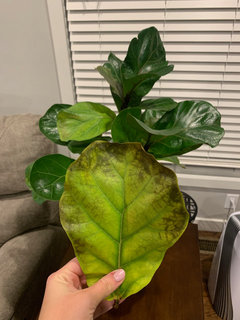

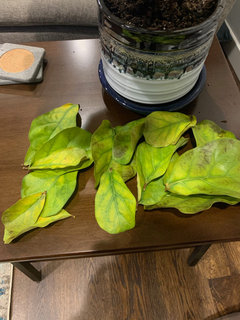
morpheuspa (6B/7A, E. PA)
3 years agoSo at this point it's been repotted into a lighter mix and fed, yes? And yes, the color change is pretty obvious, with the lime green (almost chartreuse) obvious away from the leaf veins. But they did look like that before, it's just continuing.
It's too soon for the feeding to kick in and for the adjustment to the new potted mix to really have taken effect. As long as you're watering and giving it the appropriate internal climate and light levels, I'd be inclined to ride things at least another two weeks without making any more moves that could shock the plant.
Kelly
Original Author3 years agolast modified: 3 years agoYes, as mentioned in the first update it was repotted a several days ago, 99.9% of the old soil removed, and got potted with new soil + worm castings and extra perlite. I did not water it immediately (i've heard mixed things about doing that) so I waited 2ish days and then watered it. I have not fed it other than the worm castings if you count that, I wanted to wait a bit to get it settled before introducing that. And yes its receiving adequate light, the same spot it's been in for over a year, directly in front of a south facing window.
I will hang tight, but at this rate in a few more days I have a feeling there will be no leaves left.
tropicofcancer (6b SW-PA)
3 years agoHi Kelly: You should have watered the newly potted plant immediately. In fact, the roots need to be kept wet throughout the process of repotting. If roots dry out in the process it can be a big stress for the plant and possibly kill it. The only time one does not water a newly repotted plant is for cactus and succulents. Hoping that your mix was damp enough and the roots did not get compromised a lot. Have you watered it well once so far? Also after a full repot (where the soil was completely removed) it is better to keep the plant in just a bright spot and not exposed to full Sun. A week or so is sufficient for recovery. Indoors though Sun light is not as strong as outdoors though. So that may work in your favor.
Kelly
Original Author3 years agoUnfortunately like I said, I've heard different opinions about watering right after vs waiting a few days. This is just one article that claims the opposite of you: https://pistilsnursery.com/blogs/journal/how-to-re-pot-indoor-plants-and-5-reasons-why-you-should#:~:text=After%20re%2Dpotting%20or%20potting,during%20re%2Dpotting%20have%20healed. "take care to refrain from watering until about a week after re-potting to ensure that any roots damaged during re-potting have healed." I could find several others like this and also several others agreeing with you. All I know is waiting a few days after repotting has never killed any of my plants, or even caused visual stress. However, the potting mix that I did use was very damp, so damp I could squeeze water out of it. Which was another reason I felt I should wait before watering.
tropicofcancer (6b SW-PA)
3 years agoKelly: In the above article this is what they say for step 6, the last step of repotting:
Place your plant in the new pot and fill in with soil until all roots are covered and air. Firm soil gently to ensure that there are no air pockets, but take care not to crush delicate roots. Water lightly so that the new soil is moist, but not sopping wet.
After that they say to wait for a week for the next watering. The advise there seems to be OK to me.
In general, it is not a good idea to let the roots dry out anytime during the repotting process. Roots are designed to be damp, especially the root hairs. Also a healthy plant will quickly recover from physically damaged roots.
Anyway, fingers crossed. Hopefully your plant will start turning around soon.
HU-434119357
3 years agoOk im new here Kelly and far from an expert but I had a recent issue with my fiddle and I couldn't help but notice the blur on ur leaves which looked alot like mine. I had an issue with powdery mildew that I created unknowingly from misting my living wall and moving my fiddle away from its window creating a bad situation. Anyway, long story short I had a hell of a clean up and I had to clean a whole lot of plants to include my pot, my soil, and pluck some leaves and eventually give the tree a bath or risk losing it and the leaves looked exactly like yours on the affected plants. I didnt get to take pics of the leaves from my fiddle because after reading how this mildew attacks and sticks the life out of plants, I was about 2 weeks behind from when I first saw what I assumed was dust. I neem sprayed the plants that could be saved and salvaged what I could until I ran out. It was late at night and I ran to the internet and ended up making a natural solution using baking soda and a couple other household ingredients. I carefully followed the instructions word for word and after thinking the issue was only on the surface of my soil I notice the fuzz on a stem and a few leaves as well. It was extremely light that I couldn't see it in the day time. I bathed the entire tree in the solution carefully wiping each leave per instructions top and bottom and not dripping anything. According to the things I read it's hard to recover from and from the description and the timeline of ur tree it really seems like that's also ur issue. Again I'm not expert by far but I came across this pic while trying to fix my own issue. My tree is in Quarantine but doesn't appear to be declining anymore and I check it several times a dat with my flashlight very carefully for any signs of mold. I hope this helps because I would be hurt if I lost my tree and it seems like u would too. Maybe Tapla could chime in. Good luck.
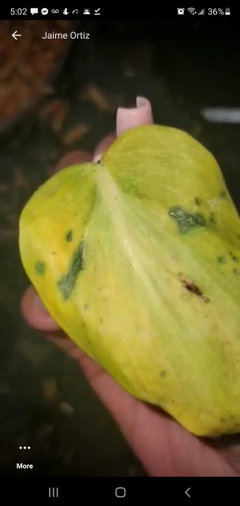
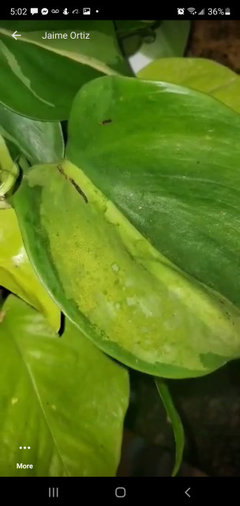
tropicofcancer (6b SW-PA)
3 years agolast modified: 3 years agoHU-434119357 The picture posted does not look fiddle leaf fig. It is some other houseplant. Peperomia? Plants do discard their lower leaves as it grows. Your first pic of yellow leaf looks like a naturally discarded leaf. The plant will re-absorb nutrients from older leaves (thus the leaf turns yellow) and eventually fall. This is normal. Low light can cause this too. I do not see anything wrong in the second pic except some mechanical damage. May be you can take a few more pics and a pic or two of the whole plant and post it here.
HU-434119357
3 years agoIn the body of my message I stated that I did not get to take pics of the leaves on my fiddle. The issue with the powdery mildew still looked the same on the leaves of every single plant I owned. I know that's not a fiddle that's y I made that very clear. Both are are the leaves of a Philo Brazil and the patches on the second wasn't mechanical damage. It was powdery mildew which did kill most of the plant despite my cleaning efforts and neem solutions. And the first leaf declined like most of the plants in the area that had the mildew on it. The water from those plants did drip on my FLF which has survived so far. Its been about a month. The fuzz looked the same on the leaf and the leaf was turning a much lighter green than it was before the mildew. Low light, poor air circulation, and misting caused the mildew which isn't normal. The living wall has since been moved and all of the plants were discarded.
Kelly
Original Author3 years agoFor what it's worth, my FLF has been pretty stable lately. The top 1/3 of plant is the only area with remaining leaves but no more more leaves have actively been falling since the last time I updated. No growth either, but we'll see where this goes!
I just posted another discussion for another one of my plants (I know, I haven't been having a lot of luck lately) and the issue appears to be unrelated to this, however this plant sits very close to my FLF so it makes me wonder.. I thought it was worth linking here if anyone has any suggestions. Thanks in advance! https://www.houzz.com/discussions/6104241/brown-spots-and-lighter-leaves-on-peperomia-pests

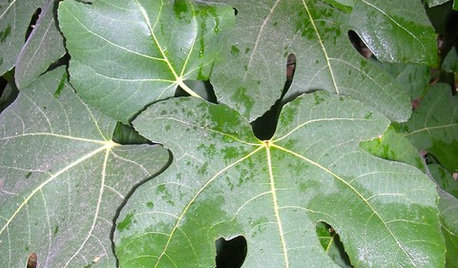





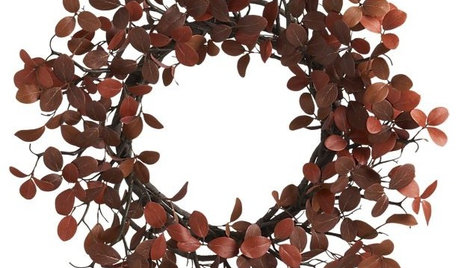







Dave